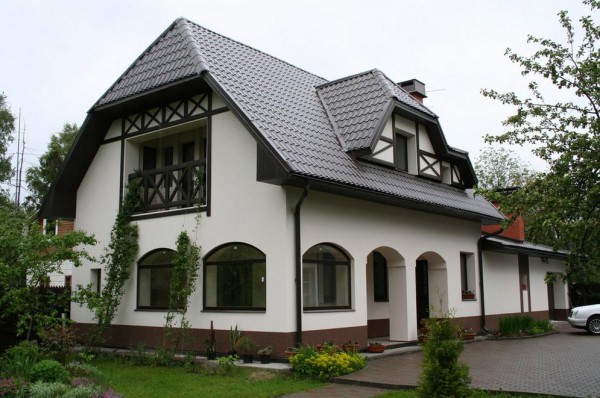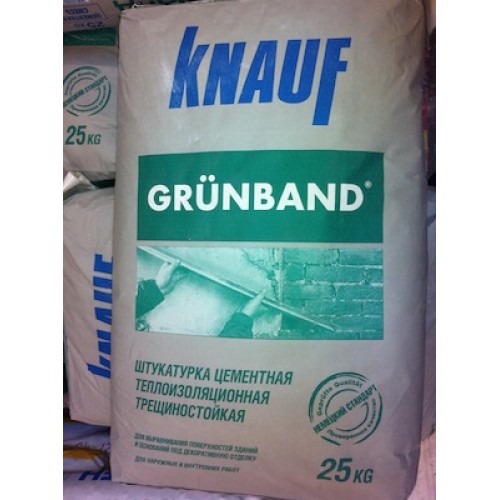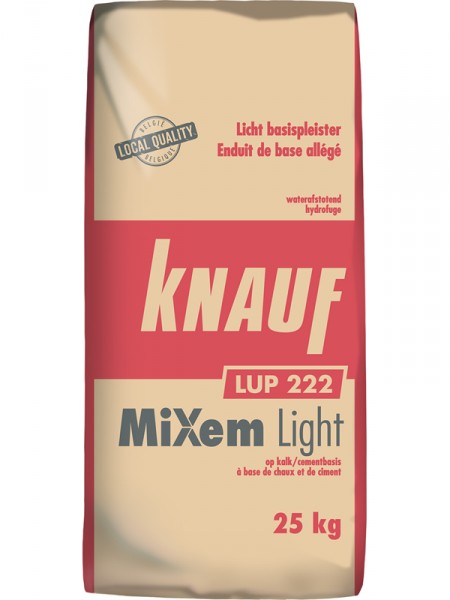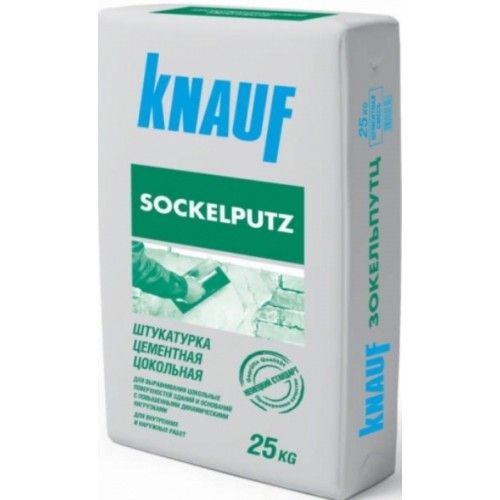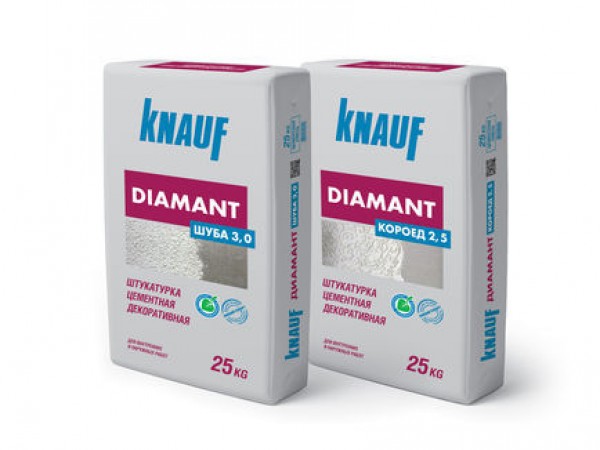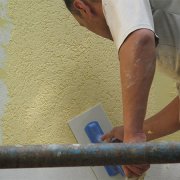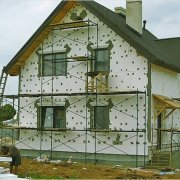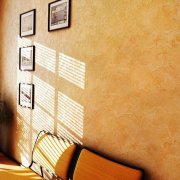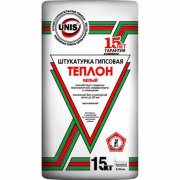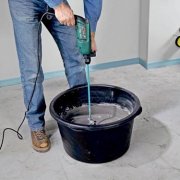Knauf facade plaster: material characteristics
In addition to aesthetic, other requirements are also imposed on the exterior decoration of houses, such as strength, frost resistance, durability, thermal insulation properties. And if a decision is made to plaster the exterior walls, then you should definitely pay attention to such material as Knauf - cement-based facade plaster. It is available in several types, among which there are leveling, and heat-insulating, and decorative compositions.
You will learn about their characteristics and scope from this article.
The content of the article
Knauf leveling plasters
No matter how smooth the masonry or the monolithic surface of the walls, they still need to be aligned (see Alignment of walls with plaster according to all the rules), elimination of defects, as well as protection against atmospheric and mechanical influences. This function and takes on the plaster.
Without dwelling on such moments as the instructions for the preparation and application of the mortar on the base, we will talk about the properties of those Knauf brand compounds that are designed for the main decoration of facades so that you can compare them and choose the most suitable one.
Grunband
This is a cement mixture with the addition of fractional sand, polystyrene granules, which provides heat-insulating properties of the plaster and reduces its weight, as well as hydrophobic additives, due to which the coating acquires water-repellent properties.
It ideally lays on the bases of concrete, silicate and ceramic bricks, expanded clay concrete blocks, foam and aerated concrete. It can be used both for facade decoration and for leveling surfaces in rooms with high humidity.
Plastered by Grünband (see Warm plaster Knauf Grünband) the surface can be painted, finished with tiles, artificial stone or decorative plaster from the Knauf-Diamond line is applied.
Specifications:
| Layer thickness | Grain | Traction strength | Compressive strength | Density | Thermal conductivity | Water absorption | Frost resistance | Coefficient of steam permeability |
| mm | mm | MPa | MPa | kg / m3 | W / m * s | % | cycle | Mg / m * h * Pa |
| 10-30 | 1,5 | 0,4 | 3,4 | 1100 | 0,35 | 15 | 35 | 0,1 |
Unterputz
Dry cement mix with fractionated sand and special additives for exterior and interior use, including in rooms with high humidity (cellars (see Cellar, underground or basement plaster), bathrooms, laundries). It is combined with any solid wall materials.
Note. The solution remains viable for 1.5-2 hours. During this time, the prepared facade plaster Knauf Unterputts must be used up, it must not be diluted with water.
The solution can be applied both manually and mechanically, using continuously working mortar-mixing pumps.
Specifications:
| Layer thickness | Grain | Traction strength | Compressive strength | Density | Water retention. the ability | Frost resistance | Koef.soprot. water vapor diffusion |
| mm | mm | MPa | MPa | kg / m3 | % | cycle | |
| 10-35 | up to 1.5 | 0,4 | 4,3-5,5 | 1650 | 98 | 25 | 12 |
LUP-222
Like Grunband, facade plaster Knauf LUP-222 has water-repellent and heat-insulating properties due to the inclusion of hydrophobic additives and a light filler (polystyrene foam granules). But the basis of this plaster is cement-lime.
The solution is suitable for application on any brick and stone substrates, it is easy to apply and smooth, the coating is vapor-permeable, weather-resistant, practically not subject to stress.
Specifications:
| Layer thickness | Grain | Traction strength | Compressive strength | Density | Thermal conductivity | Coef. water absorption | Frost resistance | Koef.soprot. water vapor diffusion |
| mm | mm | MPa | MPa | kg / m3 | W / m * s | kg / m2* h | cycle | |
| 10-30 | 1,5 | 0,4 | 3,4 | 1100 | 0,55 | 0,5 | 35 | 10 |
Sockelputz
Cement plaster increased strength, which is provided by specially introduced additives. Its purpose is to finish the basement of buildings, which does not interfere with the use of mortar for plastering facades and conducting interior work on damp rooms.
If we compare the strength characteristics, then at Sokelputts they are 2-3 times higher than that of other cement plasters of this brand.
| Layer thickness | Grain | Traction strength | Compressive strength | Density | Water retention. the ability | Frost resistance | Koef.soprot. water vapor diffusion |
| mm | mm | MPa | MPa | kg / m3 | % | cycle | |
| 10-20 | up to 1.5 | 0,4 | 10-11 | 1650 | 98 | 25 | 15 |
Note. All the above compositions require additional decorative finishes - staining, applying decorative plaster or cladding.
Decorative facade plasters
To give facades not just a smooth and neat, but also an aesthetically attractive look, decorative Knauf facade plaster from the Diamond line will help. All of the above formulations are the ideal basis for its application.
Tip. Before applying decorative plaster, you need to let the leveling mortar dry for 4 weeks, after which the facades should be treated with Isogrund Knauf primer.
Mixtures of Diamant-240 and Diamant-260 are decorative. They are made on the basis of lime and white cement with polymer additives that give increased water repellent properties and resistance to aggressive atmospheric influences.
The difference between them is manifested not only in technical characteristics, but also in appearance:
- When grouting Diamant-240 due to rolling grains with a diameter of up to 3 mm, the surface acquires a Bark beetle structure with pronounced grooves;
- Diamond-260 gives a uniformly rough surface, the so-called "fur coat".
The larger the grain size of the mineral filler in the composition of the dry mixture, the more relief the coating is obtained.
Knauf decorative facade plasters are easy to apply with their own hands due to their plasticity, just as simple the surface is textured with a trowel. But this work is best done with an assistant, since grouting should be done on a freshly applied layer.
Comparative table of technical parameters:
| Name | Compressive strength | Bending strength | Thermal conductivity | Coef. soprot. water vapor diffusion | Dry mix density |
| MPa | MPa | W / m * s | kg / m3 | ||
| Diamond-240 | 3,1 | 1,7 | 0,87 | 9,5 | 1490 |
| Diamond 260 | 4,2 | 2,6 | 0,87 | 11 | 1530 |
Conclusion
Among the many manufacturers of dry building mixes for facades, Knauf is one of the most popular in our country. This is due to the excellent quality of the products and their high reputation. There are many other high-quality materials on the market, and you can also learn about them in detail from other materials of our resource.
As for the described plasters, the opinions of specialists about them you will learn from the video in this article.
